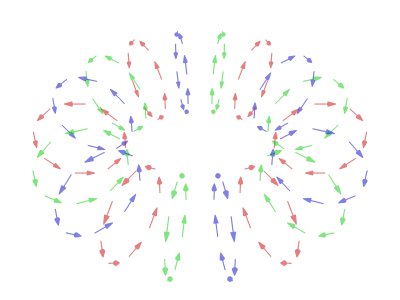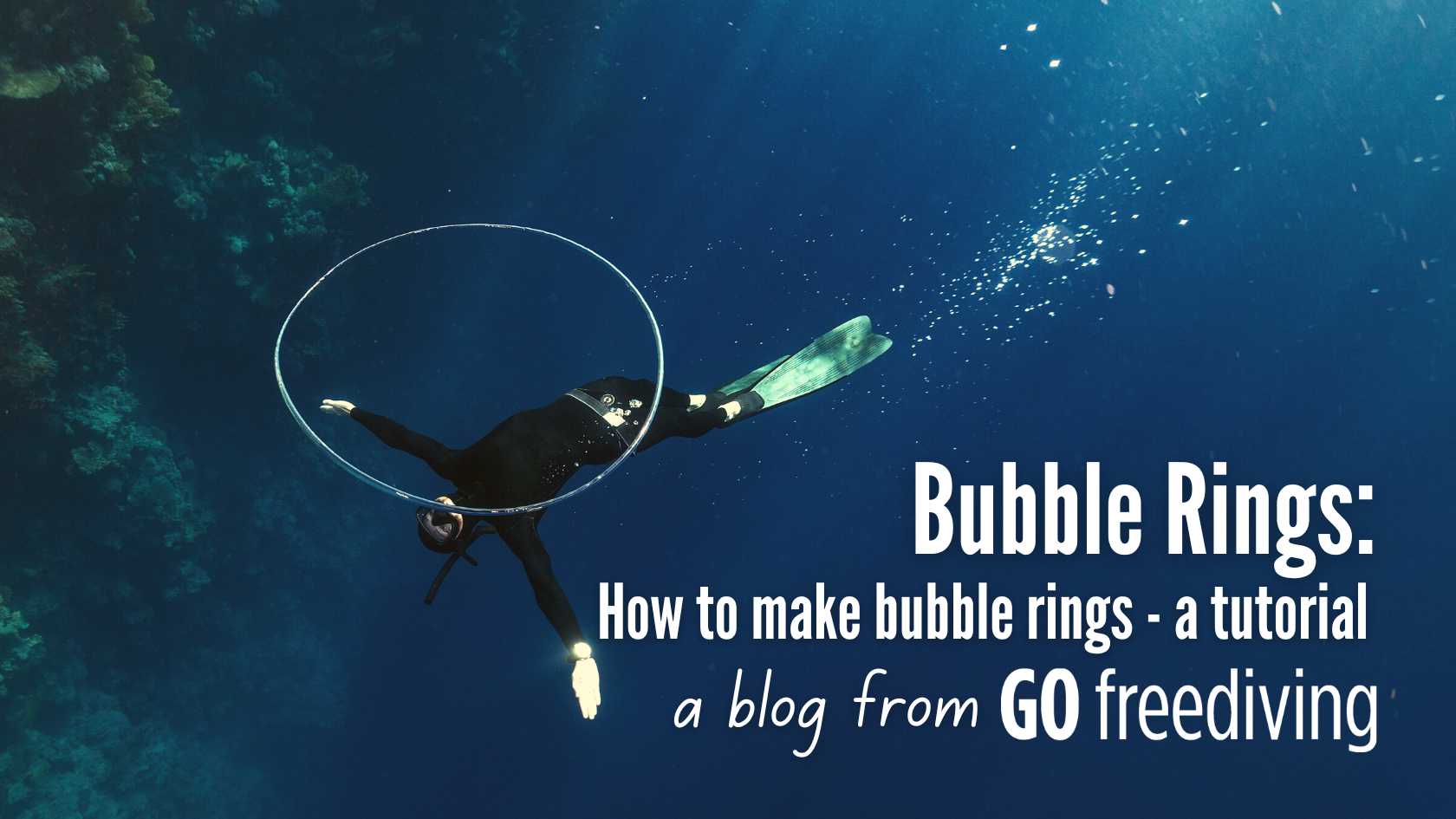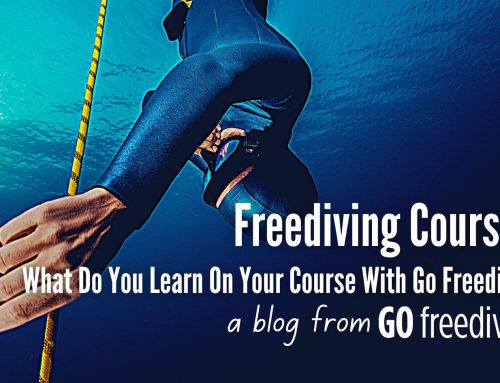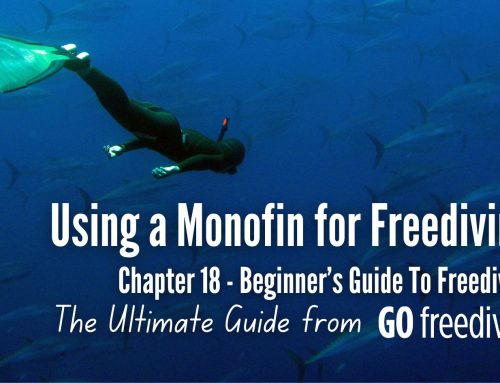Have you seen my recent video (see below, if you missed it), where I managed to blow consistent bubble rings? I was thrilled, as that was something that had eluded me for many years! But learning how to make bubble rings is a bit like riding a bike – once you can do it, you’ll never forget it. If only I had realised just how simple it was. So, get ready to impress your friends the next time you’re in the water! All you need to start is some water and a little practice.
Bubble rings can be performed regardless of whether you are vertical or horizontal, however it is easiest to learn laying on your back at the bottom of a pool and blowing ascending vertical bubble rings
Vertical Bubble Rings – A Tutorial
Step One
Step one is all about preparation, so ensure where you are going to blow your bubbles is deep enough to allow the bubbles to develop properly. You can blow bubble rings in very shallow water, but if you fancy blowing rings so large that you can swim through them, then you need to be deeper. You should also wear goggles or a mask – you don’t want air escaping from your nose, and you want to see your bubbles, don’t you?! You will also need to be able to hold your breath for at least 30 seconds.
If you are in a swimming pool, place a weight belt with at least three kilos of weight on it on the bottom so that when you duck dive down, you can place it on your body to help keep you on the bottom of the pool.
In the video above, I am wearing a weight belt with four kilos on it and a 1.6kg neck weight. This is enough for me to stay at the bottom of a two metre deep pool without moving. I would recommend that a safer option for you is to duck dive down and then put a weight belt with weight on your body to keep you under. That way, at the end of the bubble ring session, you can take it off and easily ascend.
If you are in open water then it is safest to weight yourself as normal for a dive (neutral at 10 metres) but use the line to keep you under. In open water, I duck dive away from the line to around four metres, then swim to the line and use it to hold me down. More about why I do this below!
Step Two
If you are learning how to blow bubble rings in a pool, make sure you are at the deepest point of the pool and are as low as you can get. You need to be able to lay still in the water. The reason for this is that in order to have success when starting out with bubble rings, the water above you needs to be as still as possible. If people are swimming above you, or you are thrashing your arms and legs about to stay under the water then it isn’t going to work.
The stiller the water, the easier it is for the bubble rings to form and also maintain their shape.
Duck dive down away from where you intend to blow bubble rings from and then move into position. Wait for at least ten seconds for the water above you to settle before starting your attempt. In open water, when using a line, duck dive away from it and then move at the correct depth to the line. This will help ensure that the water column above you is still.
Step Three
There are a few ways of blowing bubble rings. Some lucky people can simply spit a little bit of air out without sticking their tongue out, and a perfect ring will form. I’m not there yet so this is how I recommend you start.
Fill your cheeks with air. Compress your lips together and stick the tip of your tongue out between them. Try and imagine that you are making your lips into a circle, and that the tip of your tongue is circular too.
Create pressure in your mouth behind your tongue and lips, then spit a small amount of air out and at the same time, pull your tongue back into your mouth, closing your lips tightly shut behind it. I also find that I make the most effective bubble rings when I use my stomach muscles as well, so when I spit the air out, I sharply contract my abdominal muscles at the same time.
If you want to create larger rings, for example if you are deeper in open water and want to swim up through them, then you need more air in your mouth before you start and then expel more when you make the ring.
If you are wearing goggles, you should also pinch your nose shut (you may still want to do this if you are wearing a mask, when you first start). With practice you should find that you do not need to do this, but I think it does help.
And that’s it!
Want to be a record breaker? Check out the current world record holder and UK diver Paul Henson performing 66 of them – smashing the previous record of 47!
Told by Guinness World Records that he would have to replicate the conditions under which the previous record holder had set his record, using a publicly accessible pool, Henson chose Carlton Forum Leisure Centre. After a wobble at the beginning where one bubble collapsed, Paul sailed past the original record with 66 perfect bubble rings!:
“I waited what seemed like ages for the bubbles to clear, then, with renewed determination, I managed to clear my mind and, to my relief, produce a further 66 perfect rings.”
How To Make Vertical Bubble Rings – Tips
- Don’t be too disheartened if this doesn’t work for you first time. Practice is key.
- Practice in a pool or calm water environment, so that the bubble rings have a better chance to form.
- Keep your head very slightly tilted back and your body as straight and horizontal as possible when you start (you can move on to blowing bubble rings from different angles once you have mastered the basics of how to blow bubble rings)
- Remember, bubble rings can be created a number of different ways, so speak to others and find out what mouth shape they use, as you may find a different technique works better for you.
How To Make Vertical Bubble Rings – Trouble Shooting
- Just a bunch of bubbles come out of your mouth – It is likely you are expelling too much air, for too long and not quickly enough. You should be expelling the air very quickly, in one smooth, sharp move, and make sure that as soon as you expel the air in one quick move, you close your mouth tight.
- You create a big bubble, but no ring – It is likely your mouth shape is not quite correct when blowing and/or your head position is slightly tucked in, instead of tilted back slightly. Experiment with mouth shape and remember to expel the air quickly.
- The bubble ring doesn’t fully form, or last – It is likely this is due to the actual water. The deeper you are the better the pressure, which will help hold your bubble. If your bubble breaks up quickly this is likely to be due to too much water movement, either from you moving around or from water turbulence/currents etc.
Check out what happens when a jellyfish gets caught in a bubble ring:
What happened?
The water pressure at the bottom of the bubble is greater than at the top, so the pressure pushes the air up faster. This squeezes the bubble until the bottom meets the top and punches a hole through the middle, where water flows through.
The water then circles back down and around the air, creating a ring of vortices:

(Lucas V. Barbosa/Wikimedia/Public Domain)
Horizontal Bubble Rings – A Tutorial
If you have mastered how to perform vertical bubble rings you might want to try horizontal ones, or ones that descend vertically. These are obviously a little more tricky because when the air leaves your mouth, it all wants to rise to the surface, so you need to master some gravity defying tricks, by pulling the air from your mouth. Horizontal bubbles are created by your hands as well as your mouth.
Step One
Step one is exactly the same as when blowing vertical bubble rings. You need to be deep enough, and in calm water to be able to execute this, or at the surface, looking down over calm water.
Step Two
If you are learning how to blow bubble rings in a pool, make sure you are at the deepest point of the pool and are as low as you can get, but this time you need to stand or kneel at the bottom of the pool. If you are in open water, choose a place where you are deep enough but can feel as little water movement as possible. Remember to disturb the water as little as possible as this will affect the success of your bubble ring. The only water movement you want is what you are creating when you move your arms. In a pool you can use a weight belt on your lap to keep you in place.
Step Three
Now the tricky part! Your arm and hand positions are key to making this successful. First you need to clench your hands into a loose fist and bring your knuckles to your mouth (as if you are going to kiss the middle knuckles of each hand together). When you are learning, try to make sure your arms are both horizontal so that your elbows are at the same height as your hands.
Step Four
Fill your mouth with air, exactly as you would for your vertical bubble ring. The arm action needed when you expel the air from your mouth is the most important part. You need to extend your arms as though you are performing a breast stroke – so the arms push out straight, from the mouth, keeping the elbows at the same height as your hands. Your hand should remain closed, but relaxed and you should not bend the wrists at all. As you create your bubble ring as you would normally, quickly pull the water and air away from your mouth in a wide pulling motion.
Step Five
Speed is also an important factor, so you will need to work out what speed is needed in order to succeed. Also, remember a speed that is successful in one type of water, may not be in another.
And that’s it!
Once you have mastered vertical and horizontal bubbles, your level of coolness can escalate even further! Check out what freediver David Helderle can do! He makes it look so effortless!!
How To Make Horizontal Bubble Rings – Tips
- Don’t be too disheartened if this doesn’t work for you first time. Practice is key.
- Practice in a pool or calm water environment, so that the bubble rings have a better chance to form.
- Keep your shoulders relaxed so that the movement comes from your elbows.
- Keep your wrists straight at all times
- Remember, bubble rings can be created a number of different ways, so speak to others and find out what mouth shape they use, as you may find a different technique works better for you.
How To Make Horizontal Bubble Rings – Trouble Shooting
- Just a bunch of bubbles come out of your mouth – It is likely you are expelling too much air, for too long and not quickly enough. You should be expelling the air very quickly, in one smooth, sharp move, and make sure that you are pulling the water apart as the air leaves your mouth
- You create a big bubble, but no ring – It is likely your mouth shape and/or arms are not correctly positioned. Experiment with mouth shape, remember to expel the air quickly and pull quickly with the arms.
- The bubble ring doesn’t fully form, or last – It is likely this is due to the actual water. The deeper you are the better the pressure, which will help hold your bubble. If your bubble breaks up quickly this is likely to be due to too much water movement, either from you moving around or from water turbulence/currents etc.
Blowing Bubble Rings Is Not Unique to Humans!
We might like to think we’re pretty unique and clever when we create bubble rings, but we are not the only ones! Check out what Thorn likes to do:
Or what about dolphins? These have been observed countless times making bubble rings and playing with them:
Send us videos of you blowing bubble rings, we’d love to see them!
Learn Freediving with Go Freediving
Go Freediving is the longest established, most experienced and friendliest freediving course provider in the UK, led by world class freediving instructor trainer Emma Farrell, and her team of personally trained instructors. No other course provider has such a good instructor to student ratio, safety record and personal touch which ensures you are learning your freediving techniques from the best!
If you’re a beginner dipping your toes into the world of freediving, a seasoned pro looking to turn professional, or simply a freediver of any level who wants the best freediving holiday in the world, we’re here for you!
Also check out our online guide, The Beginners Guide to Freediving by clicking here!
Keep in touch with everything Freediving
Subscribe to our mailing list for weekly newsletters with exclusive articles, news, films, offers and more!
And check out You Tube!





